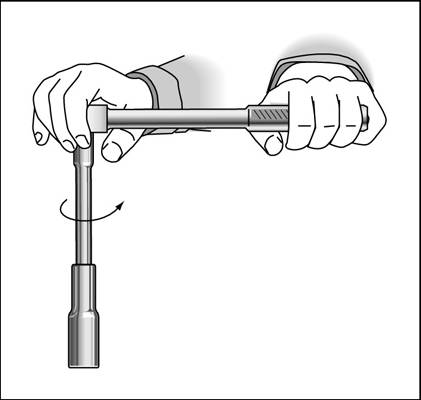How to Get Spark Plug Out
To get a spark plug out, use a socket wrench to unscrew it from the engine. You may need to use a spark plug socket for easier removal.
Replacing spark plugs is a common maintenance task that helps ensure your engine runs smoothly and efficiently. Over time, spark plugs can become worn or fouled, affecting your vehicle’s performance. Knowing how to properly remove and replace them can save you time and money in the long run.
Keep reading to learn the step-by-step process of removing spark plugs from your vehicle and why it’s important to maintain them regularly.

Credit: www.dummies.com
Tools Needed
To get the spark plug out, you’ll need a few specific tools. Start by assembling your socket wrench, socket extension, and a spark plug socket. These tools will help you easily and efficiently remove the spark plug from your vehicle’s engine, allowing for smooth maintenance or replacement.
When it comes to removing a spark plug, having the right tools is essential. Without the proper equipment, you may struggle to get the spark plug out, potentially causing damage to the plug or even to your vehicle. To ensure a hassle-free and successful removal, here are the three main tools you will need:
Wrench
A wrench is a versatile tool that can be used for various tasks, including removing spark plugs. Look for a wrench that fits comfortably in your hand and has a good grip. A wrench with an adjustable jaw size can be particularly useful as it allows you to tighten or loosen bolts of different sizes.
Socket Set
If you prefer a more specialized tool for removing spark plugs, a socket set is a great option. A socket set typically includes a ratchet handle and a variety of sockets to fit different bolt sizes. Choose a socket set with sockets in the right size range for your spark plugs.
Spark Plug Socket
A spark plug socket is specifically designed to fit over the spark plug, allowing for easy removal. It has a rubber or foam lining inside to grip the spark plug firmly and prevent any damage during the removal process. Make sure to choose a spark plug socket that is compatible with your vehicle’s spark plug size.
With these three tools at your disposal, you’ll be well-equipped to tackle the task of removing spark plugs. Remember to always follow the manufacturer’s guidelines to ensure the safety and proper maintenance of your vehicle.

Credit: www.artofmanliness.com
Preparing The Engine
To remove a spark plug from your engine, follow these steps: 1. Start by disconnecting the spark plug wire. 2. Use a spark plug socket and ratchet to loosen the spark plug. 3. Remove the spark plug carefully, avoiding any damage to the threads or electrode.
Allow Engine To Cool
Before attempting to remove the spark plug, make sure the engine is cool to avoid any burns.
Remove Spark Plug Wires
To safely proceed, disconnect the spark plug wires one at a time to prevent any mix-ups.
Removing The Spark Plug
Locate The Spark Plug
Begin by identifying the location of the spark plug in your vehicle. It is usually found near the engine cylinder.
Use The Socket And Wrench
Once you have located the spark plug, gather a socket and wrench that fit the plug size.
Inspecting The Spark Plug
Inspecting the spark plug is an essential step in maintaining the optimum performance of your vehicle. By regularly checking the spark plug, you can identify potential issues and prevent them from escalating into more significant problems.
Check For Wear And Tear
When inspecting the spark plug, the first thing you should look for is wear and tear. Over time, the electrodes and ceramic insulator of the spark plug can become worn, which can negatively impact its ability to create an efficient spark. To check for wear and tear, follow these steps:
- Disconnect the spark plug wire by firmly grasping the boot and pulling it off the plug. Be sure to avoid pulling on the wire itself as it can damage the connector.
- Use a spark plug socket and a ratchet to loosen and remove the spark plug from its housing.
- Examine the tip of the spark plug for signs of wear. Ideally, the electrode should have a sharp, pointed shape. If it appears rounded or flattened, it may be time to replace the spark plug.
- Inspect the ceramic insulator for any cracks or damage. A damaged insulator can lead to misfires or spark leakage.
Look For Deposits Or Corrosion
In addition to wear and tear, deposits and corrosion can also affect the performance of your spark plug. Deposits, such as carbon build-up, can form on the electrodes over time and hinder the spark plug’s ability to ignite the air-fuel mixture effectively. Corrosion, on the other hand, can eat away at the metal components of the spark plug, leading to poor conductivity.
To check for deposits or corrosion, follow these steps:
- Remove the spark plug from its housing as mentioned earlier.
- Inspect the electrodes for any deposits. If you notice a thick layer of carbon or other deposits, it may be necessary to clean or replace the spark plug.
- Check the metal components of the spark plug, including the shell and threads, for any signs of corrosion. If you see any pitting or corrosion, it’s best to replace the spark plug to ensure optimal performance.
Regularly inspecting your spark plug for wear and tear, as well as deposits or corrosion, is vital for maintaining the overall health and performance of your vehicle’s engine. By taking the time to inspect and address any issues promptly, you can prevent more significant problems and extend the lifespan of your spark plugs.
Installing A New Spark Plug
Installing a new spark plug is a simple yet crucial part of maintaining your vehicle’s engine performance. To ensure proper installation, follow these straightforward steps to guarantee efficient ignition and optimal engine function.
Apply Anti-seize Compound (optional)
Before installing the new spark plug, consider applying anti-seize compound to the threads. This step is optional but can help prevent the spark plug from seizing or becoming difficult to remove in the future. It also aids in maintaining the integrity of the threads, making removal easier during future maintenance. Be sure to apply a thin layer of the compound to the threads using a small brush or applicator, taking care not to overdo it to prevent excess compound from interfering with the plug’s function.
Use A Torque Wrench To Tighten
Using a torque wrench is the best way to ensure that the new spark plug is tightened to the manufacturer’s recommended specifications. Over-tightening can lead to thread damage or breakage, while under-tightening can result in improper seating, potentially causing misfiring. Consult your vehicle’s manual or the spark plug manufacturer’s specifications to determine the appropriate torque setting. Once the torque setting is determined, carefully tighten the plug, ensuring that each one is torqued to the proper specification to guarantee a secure and reliable connection.

Credit: m.youtube.com
Frequently Asked Questions On How To Get Spark Plug Out
How Do I Pull Out Spark Plugs?
To pull out spark plugs, use a spark plug socket and ratchet, loosen the plug, twist it out carefully, and inspect for wear or damage.
How Do You Get A Stuck Spark Plug Out?
To remove a stuck spark plug, apply penetrating oil, let it sit for a few hours, then use a spark plug socket and ratchet to slowly turn it counterclockwise until it loosens.
How Do You Remove A Spark Plug Without A Tool?
To remove a spark plug without a tool, grip the spark plug firmly with your fingers, and twist it counterclockwise until it comes loose. Carefully pull it out of the socket. Be cautious not to damage the spark plug or your fingers while doing so.
Which Way Do Spark Plugs Loosen?
To loosen spark plugs, turn them counterclockwise using a spark plug socket and ratchet.
How Do You Know When Spark Plugs Need Replacing?
To determine if your spark plugs need replacing, look for misfiring, poor acceleration, or increased fuel consumption.
What Tools Are Needed To Remove Spark Plugs?
You will need a ratchet, socket extension, spark plug socket, and a gap measurement tool to remove spark plugs.
Can You Remove Spark Plugs Without A Special Tool?
Yes, you can remove spark plugs without a special tool, but having the right tools will make the job easier and safer.
Conclusion
To wrap it up, removing a spark plug may seem daunting, but with the right tools and techniques, it can be a simple task. Remember to disconnect the battery and consult your vehicle’s manual for specific instructions. By following these steps and taking necessary precautions, you’ll be able to maintain the efficiency and performance of your engine, ensuring a smooth ride every time.
Keep in mind, if you’re not confident in your abilities, it’s always best to seek the help of a professional mechanic.

